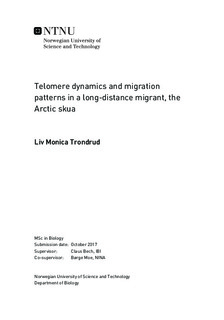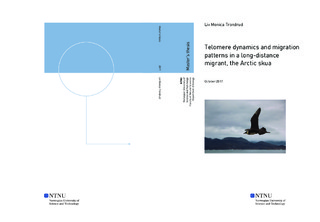| dc.description.abstract | Telomeres are protective caps at the end of chromosomes that shorten with each cell cycle as
well as by oxidative stress. In birds and mammals, telomeres shorten more slowly in long-lived species and, within species, those with a slower shortening are expected to live longer. Physiological burdens such as reproductive effort, foraging and migration patterns have all been linked to greater telomere loss in several avian species. Recent studies have shown that different aspects of migration such as overwintering habitat, timing and frequency may also play an important role in governing telomere dynamics. In the present study the relationship between telomere dynamics and individual, highly consistent, migration patterns of the Arctic skua were investigated. Adult individuals were caught and sampled during the breeding season and their migration patterns were tracked using light-level geolocation devices. The duration of migration and time spent in the wintering area, which region an individual overwintered in, and the total distances travelled, were investigated. A negative relationship between the total distances covered throughout the non-breeding season and change in telomere length was found. Increased oxidative stress as a consequence of higher overall energy expenditure is a possible explanation for this. Neither timing of migration, nor the wintering area itself, showed significant relationships with the change in telomere length. The time spent in the wintering area was positively correlated with body condition upon recapture, however, suggesting that an individuals fitness may increase by staying in the wintering grounds for longer periods of time. An unexpected, positive relationship between skull length, considered to reflect structural body size, and change in telomere length was also found. A potential explanation for this can be higher weight-specific metabolic rate and higher minimum cost of movement of smaller individuals. Positive changes in telomere length were also observed, but is suggested to reflect high maintenance of the telomeres rather than rapid elongation. The total distances flown by an individual has been identified as a potential stressor outside of the breeding season of the Arctic skua. The present study contributes to fill the knowledge gap on which aspects of the annual cycle of a species that may impact telomere dynamics and consequently survival. | |

